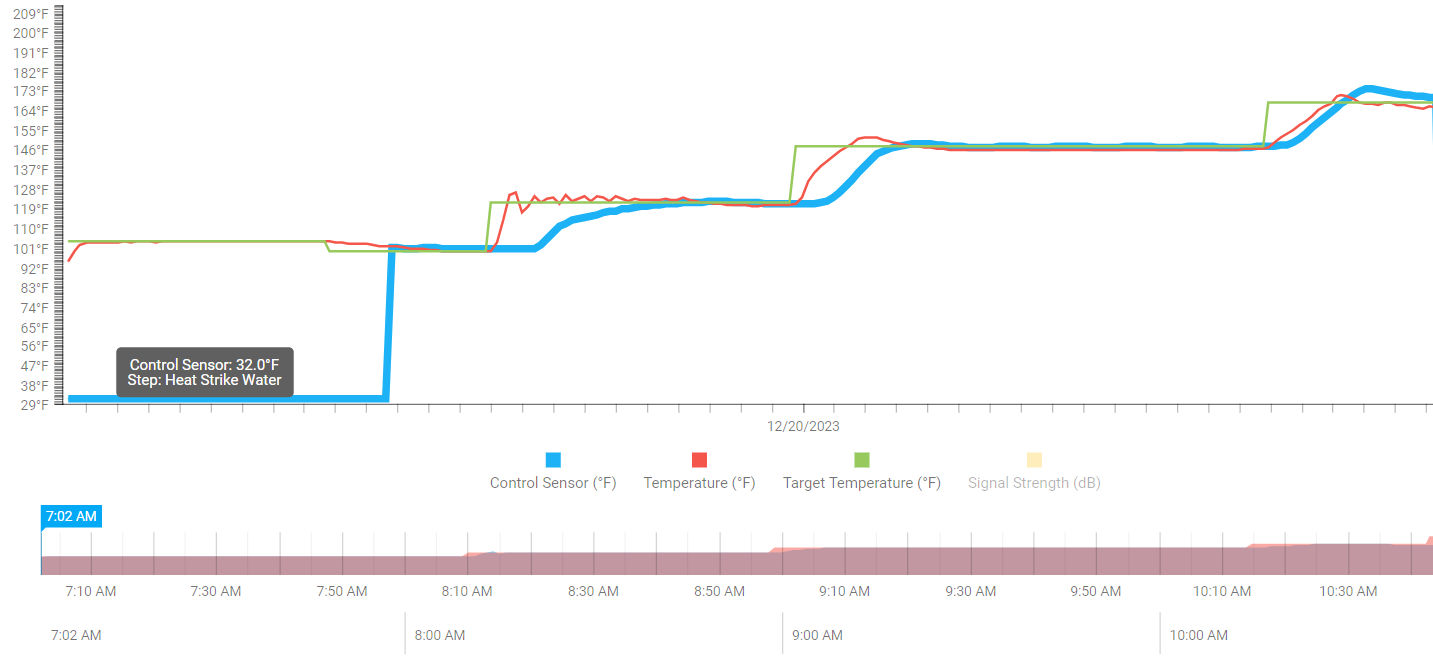What’s a good value for the temperature differential setting with Bluetooth thermometer? I seem to recall kegland’s video said something like 20 degC, but that just sounds very high. I recently bought the BT thermometer but haven’t used it yet.
BTW, did OP check the calibration of the Brewzilla temperature sensor? The factory setting on mine was waaay off.
Enzymes are very quickly denatured if they are heated beyond a certain temperature. If some part of your wort is overheated, that part can lose it's enzymes.
The higher the differential setting, the greater the chance of the enzymes you need being destroyed, and an incomplete conversion.
The maximum safe differential setting would depend on flow rate; heater power setting; and maybe PID.
If say diff = 10
°C, maximum power, and a slow flow rate, heating would cut out out once diff exceeded but the overshoot might be another 8
°C. So potentially 18
°C above the target. A lot of the current (step) enzymes could be destroyed, if they remain that hot for very long.
Setting
diff = 20°C seems way too high! with overshoots maybe 10
°C, so max 30
°C over target!
With fast flow and lower heater power, the overshoots will be less; last for shorter times; and wort spends less time in the hot zone (under the bottom / HED).
It would be good to know what PID settings would best control those overshoots in the hot zone /deadspace, but I suspect different flow rates would require different PID values.
I now run with diff = 6°C, the overshoots are around 3
°C, so max 9
°C over target.
If flow rate is slow, I reduce heating to 30%, but some of the time I'm now using
'outer recirculation' (via outside of the grain pipe) for maximum flow.
I alternate the existing hose between either: recirculation through the mash; and poking it into one of the lifting holes for 'outside circulation' (via deadspace between the walls).
For three reasons:
A) After a grain in stir, I let the bed rest, while the grains swell up. Maybe 30- 60min, before recirculating through the mash. Earlier seems to flush out flour, and risk getting a stuck mash (especially with wheat beers).
Outside circulation at max flow, while the bed is resting, helps greatly with getting to or maintaining temperature, and avoids getting a temperature gradient as the surrounding static water cools.
Instead of the mash being heated from just the bottom end, there's heat from all round as well.
On a step mash, this seemed to about halve the time taken to reach target temperature.
B) Theres 15mm of 'dead' water sitting between outside of unperforated section of the malt pipe, and the outer wall. With my typical 27l total mash volume, the dead volume is just over 4l.
Diluting the mash, with any unused water, should increase mash efficiency.
Somewhere was posted: After the mash ended, the liquid siphoned out from this gap, still looked like tap water!
C) Maximum flow can reduce hot zone temperature overshoot amplitudes and durations, or allow higher heater power while staying in overshoot limits.
Ideally, rather than alternating position and flow rate of the existing hose, I want to always recirculate at maximum flow, with as much as possible going via the grain bed, and the rest flowing outside the wall.
So I've ordered a hose to try an
outer recirculation mod - just a silicone hose from the drain tap to one lift hole (which can stay there for the mash). I'll then have two valves to control how the recirculation flow is divided, between bed and between walls.
nb. This wouldn't work on a system, where mod to move the drain tap before the pump has been done.
I've heard that some people allow overflow (through the lift holes) to get a fast flow. But I'm sure, even if using the top plate, some husks would always go with the overflow. Leading to tannins when boiled. Also, the extra weight (by difference in water levels) will tend to crush the grain bed.


































![Craft A Brew - Safale S-04 Dry Yeast - Fermentis - English Ale Dry Yeast - For English and American Ales and Hard Apple Ciders - Ingredients for Home Brewing - Beer Making Supplies - [1 Pack]](https://m.media-amazon.com/images/I/41fVGNh6JfL._SL500_.jpg)

























